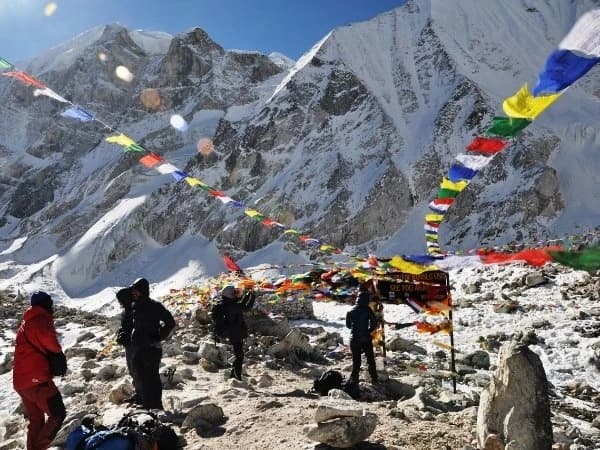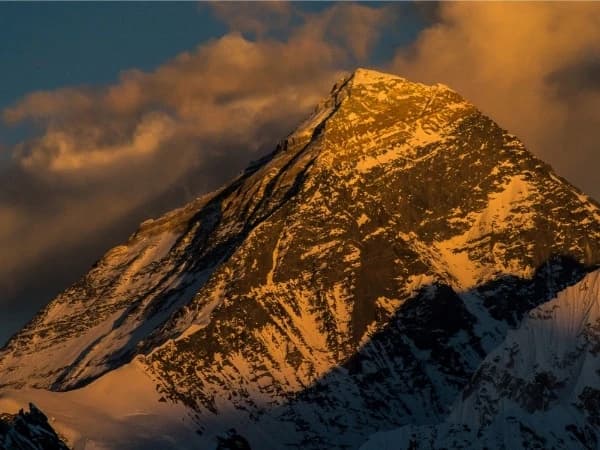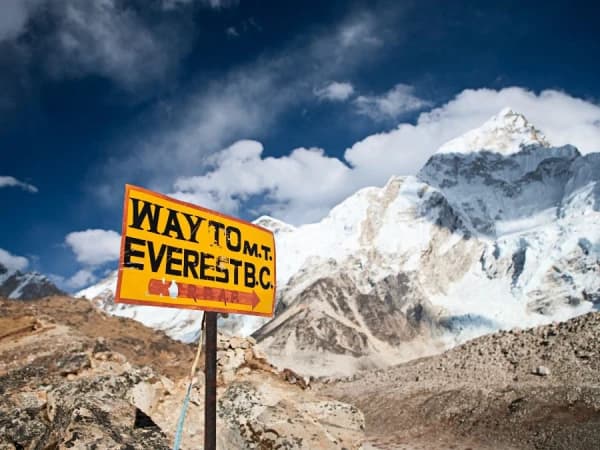What Attracts Leeches During Trek?
Before diving deep into how to get rid of leeches while trekking, or how to avoid leeches during trek, let’s learn about the nature of these slimy, blood-sucking creatures. Leeches are more active in specific conditions, which explains why some trek destinations have more encounters than others. These creatures thrive in damp, shaded areas where the ground remains moist.. They can be found under the thick forest canopies and the trail which passes through the jungle terrain, the leaf litter create ideal conditions for survival.
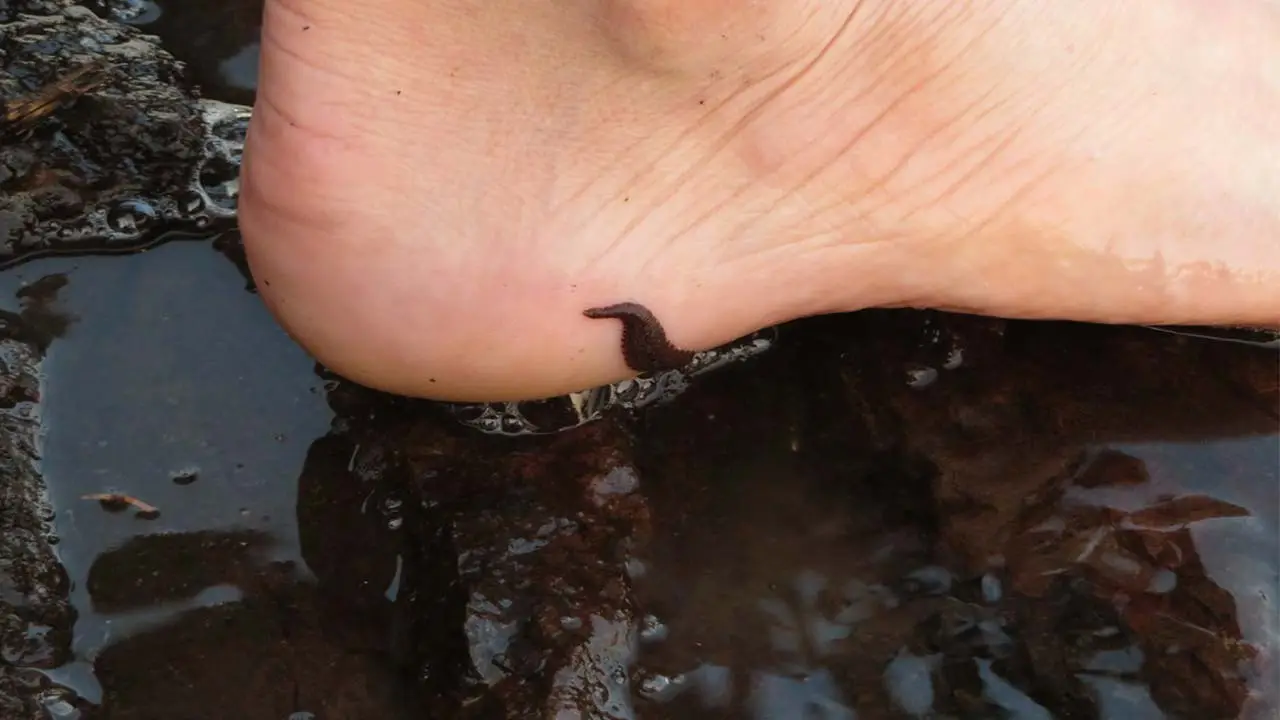
The major factor that draws leeches to the human body is heat, as they are equipped with sensors that detect warmth and vibration produced by footsteps. When someone walks by the trail, the leeches respond by stretching upward or crawling toward the movement. Leeches don't jump or fly, but they patiently wait on wet plants, grass, or the forest floor for the right moment to attach to the skin.
Humidity plays a crucial role in their activity. During and after rainfall, the moisture level of the soil rises, creating a more suitable environment for leeches. Morning treks through dew-covered paths or foggy forests can often result in higher encounters, even without recent rain.
Dense vegetation near water sources, such as small streams or puddles, greatly increases the likelihood of encountering leeches. Cooler and wetter surroundings make it more favorable for leeches to feed.
Recognizing these patterns helps trekkers adjust their routes, clothing, and rest spots. Avoiding thick underbrush, choosing drier trails, and being cautious near waterlogged sections can significantly reduce unwanted contact with these persistent forest dwellers.
How to Avoid Leeches During Trek?
Avoiding the leeches on the trail is all about preparation and awareness. While you can not eliminate them from the environment, instead of that, you can certainly reduce the chances of getting bitten with the right approach. So, without any further ado, let’s learn how to avoid leeches during trek.
First, starting from clothing, wearing light colored and tightly woven long pants with high socks. This can help you a lot to spot leeches even after they latch onto you and before they reach your exposed skin area. Tucking your pants into your socks, or you can use gaiters, which add an extra barrier that leeches can barely cross. You should avoid shorts and sandals and any exposure of skin below the knee while you are walking through thick or wet vegetation.
There are certain natural remedies that are like hidden treasures and the ultimate answer to how to avoid leeches during trek. These remedies act as deterrents; many trekkers in humid regions use mixtures like mustard oil, tobacco-infused oil, or even local herbal blends, which discourage leech attachment to skin. These mixtures are often applied around the ankle, shoes and on the lower legs.
Properly timing your hike will make a huge difference too. Leeches are mostly active in the early morning and during or after the rainfall, so choosing dry, sunny parts of the day and staying on the open and well-maintained paths can reduce leech encounters. You should avoid sitting directly on the ground or resting in a heavily vegetated area. And, if you need a break, choose dry rock or sunlit patches and stay away from thick undergrowth.
Finally, keep moving because leeches need a moment to crawl and find a spot to attach; constant movement reduces the time they have to settle. By combining smart clothing choice, natural deterrents and being a little more aware of the surroundings, you can stay focused on track without constantly watching your feet.
How to Get Rid of Leeches While Trekking?
Avoiding the leeches on the trail is all about preparation and awareness. While you cannot eliminate them from the environment, you can certainly reduce the chances of getting bitten with the right approach.
First, starting from clothing, wearing light-colored and tightly woven long pants with high socks can help spot leeches before they reach your skin. Tucking your pants into your socks, or using gaiters, adds a barrier that leeches can hardly cross. Avoid shorts, sandals, or exposing skin below the knee in thick or wet vegetation.
There are natural remedies that work as deterrents. Many trekkers use mustard oil, tobacco-infused oil, or herbal blends, usually applied around the ankle, shoes, and lower legs to discourage leech attachment.
Properly timing your hike makes a big difference. Leeches are more active in the early morning and after rainfall, so choosing dry, sunny times and staying on open paths reduces encounters. Avoid sitting on the ground or in thick vegetation—choose dry rocks or sunlit spots instead.
Finally, keep moving. Leeches need a moment to attach, so constant movement limits their chances.
By combining clothing choices, natural repellents, and basic awareness, you can enjoy the trek without worrying about leeches.
How to Deal With Leeches on Trek in Nepal?
Nepal’s lush trekking trails offer unforgettable scenery. But during the monsoon season in the lower altitudes, this rainy season brings frequent leech encounters. The low-altitude trekking regions become a hotspot for leech activity from June to early September.
Local guides and seasoned Nepalese trekkers use simple but effective methods to deal with leeches. The common practice for getting rid of leeches during the rainy season is based on a natural remedy: experienced trekkers and porters apply mustard oil mixed with tobacco to their legs and shoes.
The strong scent and bitterness repel leeches so they won’t latch onto your body while trekking. Some tea house owners sell homemade solutions during the monsoon. Wearing leech socks, widely available in Nepali trekking stores, is another local trick. These tightly woven, knee-length coverings over your socks and pants block leeches without chemicals and are a great alternative for dealing with leeches on trek in Nepal.
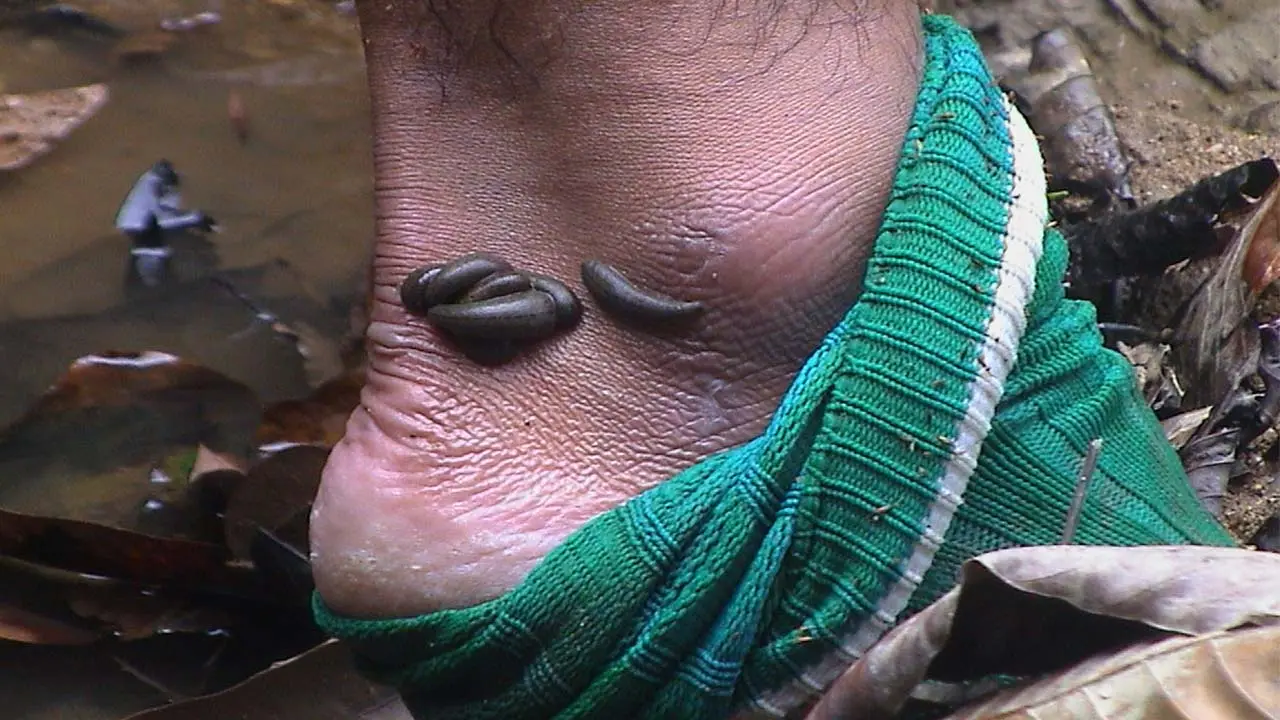
When a leech bites, locals don’t panic; they simply flick the leech off with a twig or apply salt or lime juice to make it drop naturally. Some guides and porters carry small pouches of salt for this purpose. Doing frequent clothing checks is also common, and trekkers often inspect their boots and socks during rest breaks, especially after walking through damp or muddy slopes.
The best advice from local porters and guides is to keep moving, stay dry, and don’t stress over occasional bites because it’s part of the adventure. With a calm mindset and the right local techniques, Nepal’s trails remain enjoyable even if you have to share them with these tiny creatures during the wet seasons.
Post-Trek Care and Bite Recovery
After a leech encounter, proper aftercare is very important to avoid infection, irritation, or scarring. Leech bites are harmless, leaving a small open wound that bleeds for a while due to anticoagulants in leech saliva. This is normal and not a cause for concern.
When you’re off the trail, start by cleaning the affected area with clean water and mild soap to remove dirt or bacteria. Applying antiseptics like iodine or chlorhexidine helps prevent infection. You can use a small adhesive bandage if bleeding continues.
Mild itching and redness are common. Applying anti-itch cream or aloe vera gel can reduce discomfort. Avoid scratching to prevent secondary infection or scarring.
Some people may notice mild swelling or firm bumps a day or two after the bite. This usually goes away on its own. Drinking enough water and keeping your legs elevated after a long trek supports recovery, especially if you had multiple bites.
Most importantly, treat the experience as part of the journey. Leeches are annoying but not dangerous. With basic hygiene and care, the effects disappear quickly—leaving you with stories about these little creatures on your Himalayan adventure.
Best Season to Trek without Leeches?
The most effective way to avoid leeches entirely and the most ideal answer to the how to deal with leeches on trek in Nepal question is to plan your trek during the dry season. In countries like Nepal, leeches are primarily active during the Monsoon months, from June to early September. As these are rainfall and humidity months, they provide perfect breeding conditions. If you are hoping for a leech-free adventure, then avoiding these months is a key.
The autumn season (late September to November) is considered to be the best time for trekking in Nepal. During this period, the weather is dry and stable, skies are clear and trails are free of both mud and leeches. This season offers better visibility of mountain views and also minimizes discomfort caused due to wet and slippery paths.
Another excellent time is the Spring Season ( March to early May), but this period may have occasional showers. The trails remain mostly dry and leech presence is so minimal compared to monsoon. Spring also brings blooming rhododendron forests, especially in lower regions which adds vibrant color to your trek.
If you are thinking about trekking at higher altitudes (above 2,500 meters), such as in Everest Base Camp, Manaslu, or Upper Mustang, leeches are rarely a problem regardless of the season. These drier, alpine zones are too cold and barren to support leech populations.
To ensure a more enjoyable experience, you should always research seasonal conditions before choosing a tree king route. Avoiding peak leech season, it not only improves trail comfort but also enhances scenery, safety and overall satisfaction for you.
If you pick the right time of the year,y ou can reduce the need for repellents and extra precautions, which makes our journey more relaxed and focused on nature's beauty rather than its smaller and unwanted residents.
Final Tips and Packing Checklist?
Little preparations can go a long way when trekking in a place where leeches are active. Beyond just avoiding bites, staying calm and well equipped packing list can make the experience a manageable and stress-free adventure. Below are some of the tips for how to get rid of leeches while trekking and a very simple packing checklist to help you stay ready :

Essential Tips
- Stay Calm: If a leech is attached to your skin or clothes, don't panic first, focus on removing it gently and cleaning the bite.
- Keep Checking: You should inspect your boots, socks and pants during breaks because early detection prevents leech bites.
- Choose Campsites Wisely: You should avoid camping near still water or dense vegetation during the Monsoon.
- Listen to Locals: You should listen to guides and porters; they often have a time-tested method for repelling and handling leeches.
- Stay on the Trail: Straying away from the trail onto tall grass or bushy areas increases your chances of contact.
Packing Checklist
Being mentally and physically prepared turns a potentially annoying situation into a minor inconvenience. With all of these tips and essentials in your backpack, you will be ready to focus on what truly matters and freely enjoy adventure, scenery and the freedom of the trail.
- Leech Socks or Gaiters: Protect ankles and lower legs effectively.
- Long Trekking Pants: Lightweight but tightly woven fabric works best.
- Anti-Leech Oil or Natural Repellent: Mustard oil with tobacco, citronella and eucalyptus-based sprays.
- Small Salt Pouch: Useful for detaching leeches without direct contact.
- Antiseptic Wipes or Solution: For cleaning bite areas.
- Band Aids or Small Bandages: In case of persistent bleeding.
- First Aid kit: Include antihistamine cream for itching or swelling.
- Extra Socks: Wet socks attract leeches, so dry pairs help you to stay comfortable.
- Plastic Bags: For disposing of used bandages or storing damp clothes.
Conclusion
Trekking in regions like Nepal offers a very rare blend of natural beauty, cultural richness and personal challenges too. While the idea of dealing with leeches may seem daunting at first, the truth is that leeches are a minor inconvenience when compared to the vast rewards of the trail. Having proper preparations and a clear understanding of how to prevent and manage encounters where you can turn what might seem like discomfort into a manageable part of your outdoor journey.
By the help of this guide, we have covered essential insights on how to avoid leeches during trek, how to get Rid of leeches while trekking and also helpful information about how to deal with leeches on trek in Nepal as well as removing them safely and caring for bites post trek.
If you're trekking in humid Lowlands during the monsoon or exploring a damp forest trail in spring, a few practical habits like using leech socks, packing repellent and dressing appropriately can make a significant difference. We have also explored some of the local methods and expert tips from the Nepalese trail, which help you to handle the challenge in the same calm, practiced way that locals do.
Leeches are a natural part of the ecosystem that trekkerspass through. Rather than viewing them as a threat, it will help to see them as a reminder that you are walking through living, breathing landscapes. With the right mindset, they become just another part of the story as a small obstacle in a grander adventure.
So, as you are preparing for your next big adventure, let this knowledge and awareness replace your hesitation. Don't let leeches stop you from reaching those misty viewpoints, amazing peaceful forests and soul-stirring horizons. Equipped with confidence and care, you will not just enjoy a leech-free journey, but you will return with a heart full of memories that will be worth every step.






